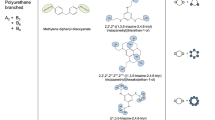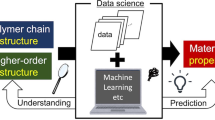Abstract
Review articles in the field of polymer science in the seventies are analyzed in order to check their usefulness in describing at a very low cost the development or the state of the art of a field. Results are compared with those obtained through a quantitative study of scientific articles published at the same time in the field. Review articles can be regarded as defining a research programme attempting to link together two networks: polymer properties—as being desirable from market considerations—and polymer structure—as being analyzable by means of academic science, through three kinds of “translation” strategies. If we thus define a research programme in terms of the mobilization of networks, it is possible to say of review articles that they provide a good representation of the development of networks of problems whose evolution they sketch.
Similar content being viewed by others
Notes and references
See E. GARFIELD,Citation Indexing, New York Wiley, 1979. For a theoretical treatment of citation analysis, see: B. LATOUR,Science in Action, Harvard University Press, 1987.
H. SMALL, E. SWEENEY, Clustering the Science Citation Index using co-citations,Scientometrics, 7 (1985) 391–409.
M. CALLON et al.,Mapping The Dynamics of Science and Technology, MacMillan, London, 1986.; L. LEYDESDORFF, Various methods for mapping of science,Scientometrics 11 (1987) 291–324. For recent methodological developments, see: R. J. W. TIJSSEN, J. De LEEUW, A F. J. Van RAAN, A method for mapping bibliometric relations based on field-classicication and citation analysis, forthcoming. For an extension of mapping methods to engineering science, see: E. KRANAKIS, L. LEYDESDORFF, Teletraffic Conference: Studying a Field of Engineering Science (this volume) and also H. PETERS, D. HARTMAN, A. F. J. Van RAAN, Monitoring advances in chemical engineering, (forthcoming). Moreover, any distinction between the analysis of single texts and of collections of texts is largely arbitary. Thus the study of any given article leads inevitably to finding other related rrticles, through the intermediary of its citations or of its vocabulary: a paper cannot be separated off from all the others it refers to or that refer to it. Inversely, developing a cartography of science and giving a meaning to the results obtained presupposes that one is drawing on a theory of the development of knowledge, and more particularly of the individual contribution of articles to this development: co-citation clusters would be meaningless without reference to the Kuhnian model, in the same way as co-word networks would be difficult to interpret without translation theory.
B. LATOUR, op. cit.Science in Action, Harvard University Press, 1987.
A. RIP,Mapping of Science, Possibilities and Limitations, in: A. F. J. Van RAAN (Ed.), Elsevier's Handbook of Quantitative Studies of Science and Technology.
The PASCAL base is produced by the CNRS (National Centre for Scientific Research). It currently contains more than five million references covering all scientific and technical disciplines. It is growing at the rate of roughly four hundred and fifty thousand references a year. As well as periodical articles, it includes theses, books and government reports.
S. ZELDENRUST,Trends in Dutch and Polymer Science, Wetenschapsdynamica, Universiteit von Amsterdam, Neuewe Achtergracht 166, 1078 WV Amsterdam.
M. CALLON, J.-P. COURTIAL, F. LAVILLE, Indicatorss of knowledge development for evaluating the impact of research support: The case of the science of polymers, Grant NSF PRA 8512982. A complete report will be available in June 1988.
K. KNORR,The Manufacture of Knowledge, Oxford, Pergamon Press, 1981: M. LYNCH,Art and Artifact in Laboratory Science: A Study of Shop Work and Shop Talk in a Research Laboratory, London, Routledge & Kegan Paul, 1985.
For a study of texts written by scientists who received public funding, see: A. RIP, M. HENNEKAM, Acknowledging Funding in Biotechnology and Bioengineering, Amsterdam, July 1985, Report to the US National Science Foundation.
Several authors have emphasized the value of studying the introductions to scientific articles. See A. RIP, op. cit. and also J. LAW, The heterogeneity of texts, in: M. CALLON and al. (Eds).
For a stimulating sociological analysis of these ways of writing and the relation that they from see: E. M. GERSON, S. L. STAR,On the analysis of Weak structure, Tremont Institute, 1986.
M. CALLON, Some elements of a sociology of translation: Domestication of the scallops and the fishermen, in: J. LAW (Ed.)Power, Action and Belief, Sociological review monograph no 32, London, Routledge & Kegan Paul, 1986.
P. COHENDET, M. J. LEDOUX, E. ZUSCOVITCH (Eds),Les matériaux noueaux: dynamique économique et stratégie européenne, Economica, Paris, 1987.
S. ZELDENRUST, op. cit.Trends in Dutch and Polymer Science, Wetenschapsdynamica, Universiteit von Amsterdam, Neuewe Achtergracht 166, 1078 WV Amsterdam.
For more details of the method, see J. P. COURTIAL, ‘Qualitative models, quantitative tools and network analysis’, this issue.
Author information
Authors and Affiliations
Additional information
We are sad to inform our scientometric colleagues that this is F. Bastide's last contribution as she died in the autum of 1988.
Rights and permissions
About this article
Cite this article
Bastide, F., Courtial, J.P. & Callon, M. The use of review articles in the analysis of a research area. Scientometrics 15, 535–562 (1989). https://doi.org/10.1007/BF02017070
Received:
Issue Date:
DOI: https://doi.org/10.1007/BF02017070




